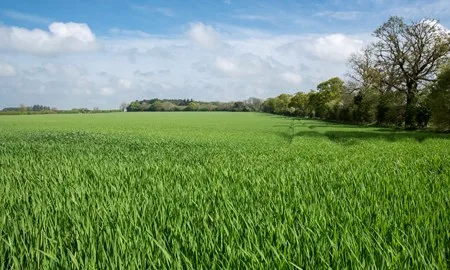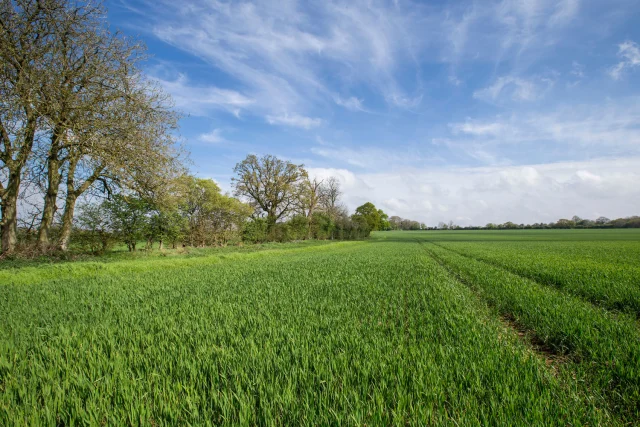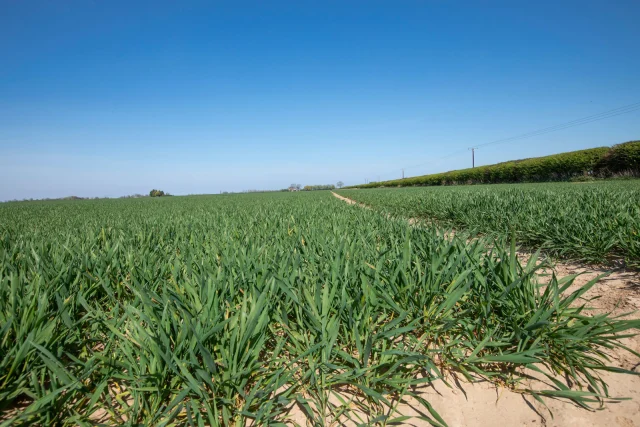Published on 1st March 2022
Local Insights
Six tasks for arable farmers in the south to consider this March

Richard Prankerd lists six potential activities for arable farmers in the south to consider this March. Hear the latest advice for your farm from your local technical manager.
Six tasks for arable farmers in the south to consider this March Content
Crop Progress
The cold in January did check crops a bit, but overall winter wheat has emerged from winter looking very healthy.
Massive flocks of pigeons landing on oilseed rape is a concern, while the main disease in all crops so far has been powdery mildew. Other wheat diseases were flying a bit under the radar at the end of February, but there were some reports of yellow rust in Zyatt following the balmy weather around New Year. Frosts since then have kept it at bay. Septoria is average for the time of the year.
Richard’s agronomy tips for March
1. Prioritise contact herbicides in wheat
Autumn residual programmes have worked well, so hopefully in most cases there should be lower numbers of grass weeds left to control this spring. Unfortunately, black-grass, ryegrass and bromes are never fully controlled so it is important to finish the job and reduce the weed seedbank for the following year.
Some growers at least considered taking advantage of a potential window in early February for applying contact herbicides in wheat, but the storms in the middle of the month have probably stopped any further activity until March.
When you can travel again and conditions are right – actively growing weeds, a dry leaf and healthy crop, with not too much difference in day and night temperatures – a robust, all-round product, such as Pacifica Plus (mesosulfuron + iodosulfuron + amidosulfuron) will be a good option.
It brings in both grass weed control and a large range of broadleaf weeds from the amidosulfuron element. It is strong against weeds such as chickweed and mayweed that are becoming more tricky to control, and also gives good control of fumitory especially compared with pyroxsulam + florasulam.
If brome is your main target species then Monolith (mesosulfuron + propoxycarbazone) might be a stronger option, particularly for the Bromus species – soft, meadow and rye brome. In our weed screen trials around the country, Monolith has the edge over Pacifica Plus in controlling these challenging species. Against sterile brome there’s not much difference between the products.
2. Consider March T0 fungicides in wheat and barley
The main driver for T0 sprays in wheat, and also winter barley to some extent, will be rust – yellow in wheat, brown in barley. Check varietal susceptibility and monitor crops carefully during March for infections.
In winter barley, early infections of mildew, Rhynchosporium and net blotch can also threaten tiller survival. Damping down any disease present and getting the programme off to a clean start is a good idea. Application of Proline (prothioconazole) at 0.3-0.4 L/ha at this early stage should cover all those diseases. If it is just mildew then a straight mildewicide would suffice.
Getting top of yellow rust as quickly as possible in wheat is important, as once it gets away, you are always chasing it. Where it is a threat, tebuconazole is the best option at T0, especially if the yellow rust is active.
Applications in wheat are likely towards the end of the month, while it could be mid-March in winter barley.
3. Focus on tiller retention in winter barley
Yield is determined by tiller retention in winter barley, rather than grain sites in the ear as for wheat, so the first main spray timing at GS30/31 is the key timing for disease control as disease during this period can cause tillers to be aborted.
A new option for this season is Ascra (bixafen + fluopyram + prothioconazole) which is approved on all varieties of barley, including malting varieties. It can only be used once in the crop, so determining when best to apply it will be down to what diseases you are most worried about.
We’ve seen good results from Ascra in the AHDB fungicide performance trials for net blotch control, which is becoming increasingly hard to control due to resistance. It also gives good control of the other main barley diseases, so using it at T1 at 0.9 L/ha is a strong option. Containing two SDHI active ingredients it also gives plant physiological benefits.
Another option, if Ramularia is the main concern, is to start the programme with Siltra (bixafen + prothioconazole) at 0.6 L/ha and then follow up with Ascra at T2 as it also has activity against that disease.
4. Consider using new CropCheck service to assess disease risks
Expanding on our Rapid Disease Detection service from last season, this season’s CropCheck service includes testing for latent infections of Septoria and yellow rust in winter wheat, Rhynchosporium and net blotch in winter barley, as well as light leaf spot and other diseases in oilseed rape.
The CropCheck service in wheat and barley uses PCR analysis of the leaf to assess whether a disease is present in the leaf before it is showing symptoms giving extra information to help you understand risk in your crops.
It’s important that it’s not used as the only part of your decision-making process though – it is only a snapshot in time and all the other factors you would normally use to help with decision-making, such as variety choice, weather, drilling date, etc., are equally, if not more important.
To register your interest in CropCheck click here.
5. Check oilseed rape for light leaf spot and cabbage stem flea beetle
Pigeons were hammering oilseed rape crops in the south, and you also should check stems for cabbage stem flea beetle larvae, which might have a detrimental effect. However, it will also make sense to look after oilseed rape with the high commodity prices.
That includes disease control, where you might have to top up your light leaf spot control at the stem extension timing, depending on risk and when you last sprayed. Our SpotCheck service, part of CropCheck, is available until the end of March to check for light leaf spot and other disease infections in the crop.
If you need to apply a fungicide, we’d recommend Proline (prothioconazole) at 0.32 L/ha. You could also include tebuconazole on more forward crops that need some growth regulation.
6. Have you thought about Velum Prime in potatoes?
On the south coast, first and second early potatoes have and will be going in, especially on lighter land.
This is the third season for our nematicide Velum Prime (fluopyram) for the control of potato cyst nematode. A key benefit of using it is its very low use rate, which is good for storage and operators. It also has flexible application – either as an in-furrow application or as an overall spray, which then needs to be incorporated.
For the latter method time your application for after destoning, and then rotavate / cultivate into a depth between 10 and 30 cm to give an even level of protection of the soil around the tuber.
In lower risk PCN situation Velum can be used alone, but in medium to high pressure it’s better to use it in conjunction with a half rate granular nematicide.



